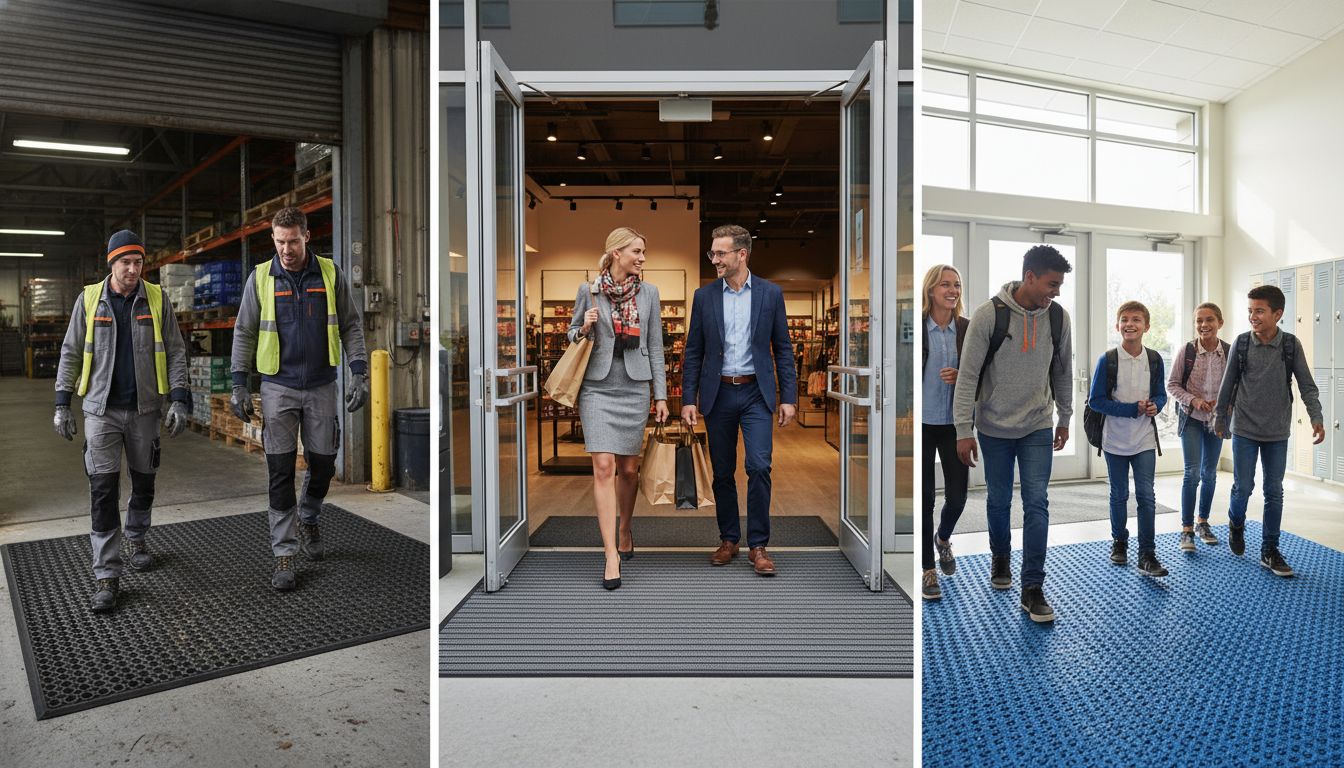Did you know that the right entry mat can trap up to 80 percent of dirt and moisture before it enters a building? For businesses, keeping entryways clean and safe is not just about appearance. High-traffic areas face constant wear, and the wrong matting can mean more cleaning, damage, and slip risks. Understanding what sets heavy duty entry mats apart helps businesses make smart choices for durability, hygiene, and safety.
Table of Contents
- Heavy Duty Entry Mat Defined And Explained
- Types Of Heavy Duty Entry Mats For Business
- Key Features And Construction Materials
- Essential Applications Across Industries
- Installation, Maintenance, And Cost Considerations
Key Takeaways
| Point | Details |
|---|---|
| Durability and Functionality | Heavy duty entry mats are designed for high foot traffic, providing durability and essential safety features like slip resistance and moisture trapping. |
| Variety of Materials | Different mat types, such as nylon, polypropylene, and rubber, cater to specific environments and needs, enhancing their performance. |
| Critical Applications | These mats are crucial in various sectors, including healthcare and manufacturing, to maintain hygiene and prevent slip hazards. |
| Strategic Implementation | Installation and maintenance strategies are essential for optimizing performance, with considerations for sizing, material, and regular cleaning protocols. |
Heavy Duty Entry Mat Defined and Explained
A heavy duty entry mat is a specialised floor covering designed to handle intense foot traffic and challenging environmental conditions in commercial and industrial settings. According to Wikipedia, these mats serve critical purposes beyond simple floor decoration: they clean items passed over them, protect underlying surfaces, and provide essential comfort and safety.
These robust floor solutions are engineered to withstand significant wear and tear while performing multiple functional roles. Unlike standard entrance mats, heavy duty variants are constructed with superior materials and reinforced construction techniques that enable them to trap substantial amounts of dirt, moisture, and debris effectively. They typically feature dense, tightly woven fibres or robust rubber compositions that can endure constant pedestrian movement, wheeled equipment, and harsh environmental conditions.
Key characteristics of heavy duty entry mats include:
- Exceptional durability for high traffic areas
- Advanced dirt and moisture trapping capabilities
- Resistance to wear from constant foot traffic
- Enhanced slip resistance for improved workplace safety
- Ability to withstand extreme temperatures and environmental conditions
For businesses seeking comprehensive entrance protection, a comprehensive guide to entrance mats can provide deeper insights into selecting the most appropriate solution for specific operational requirements. Whether installed in warehouses, retail spaces, or industrial facilities, these mats represent a critical first line of defence in maintaining clean, safe, and professional environments.
Types of Heavy Duty Entry Mats for Business
Businesses require diverse heavy duty entry mat solutions to address specific environmental and functional challenges. According to AJ Products, commercial entrance mats are engineered for high-traffic environments and come in multiple sophisticated variations tailored to different operational needs.
The primary types of heavy duty entry mats include:
- Nylon Fiber Mats: Highly absorbent and excellent for trapping moisture, ideal for office and retail environments
- Polypropylene Mats: Durable synthetic mats with strong scraping capabilities for removing dirt and debris
- Rubber Mats: Robust solutions with aggressive scraping properties, perfect for warehouses and industrial settings
- PVC Mats: Versatile and hard-wearing, suitable for schools, gyms, and high-moisture areas
- Combination Mats: Multi-zone designs that incorporate different materials for comprehensive dirt and moisture management
Each mat type offers unique advantages depending on specific business requirements. Warehouses might prioritise heavy-duty rubber mats with extreme durability, while corporate offices could prefer sophisticated nylon or polypropylene options that balance professional aesthetics with functional performance.
Here’s a comparison of the main types of heavy duty entry mats for businesses:
| Mat Type | Key Benefits | Recommended Environments |
|---|---|---|
| Nylon Fibre | Excellent moisture absorption Soft surface |
Offices Retail shops |
| Polypropylene | Durable Strong dirt removal |
Corporate buildings Reception areas |
| Rubber | Robust Superior scraping Slip resistance |
Warehouses Industrial sites |
| PVC | Versatile Withstands moisture Long lasting |
Schools Gyms Wet areas |
| Combination | Multi-zone cleaning Comprehensive control |
High-traffic entrances Mixed-use venues |
For businesses seeking comprehensive guidance on selecting the most appropriate entrance matting solution, the ultimate guide to heavy duty entrance mats provides in-depth insights into matching mat characteristics with specific operational environments. Understanding these nuanced differences ensures businesses can make informed decisions that protect their floors, maintain hygiene standards, and create safe, professional entry spaces.

Key Features and Construction Materials
Heavy duty entry mats are engineered with sophisticated materials and advanced construction techniques to withstand extreme environmental challenges and operational demands. According to AJ Logistics, these specialized mats can be constructed from 100% recycled high-density polyethylene (HDPE), demonstrating both durability and environmental responsibility.
Construction Materials for heavy duty entry mats typically include:
- High-Density Polyethylene (HDPE): Extremely robust, load-bearing material supporting substantial weight
- Recycled Synthetic Fibers: Environmentally conscious options with superior durability
- Rubber Compounds: Offering exceptional grip and resistance to wear
- Polypropylene: Lightweight yet strong synthetic material
- Nylon: Highly resilient fiber with excellent moisture absorption
Key features that distinguish heavy duty entry mats include multi-functional design elements such as multiple connection points, dual-surface traction capabilities, and load-bearing capacities. These mats are engineered to support significant weight while providing slip resistance for both pedestrian and vehicular traffic.
Businesses seeking comprehensive mat solutions can explore 7 essential tips for choosing front door mats to understand how specific material characteristics translate into practical workplace performance.
 From industrial warehouses to corporate environments, the right mat construction can significantly enhance safety, cleanliness, and operational efficiency.
From industrial warehouses to corporate environments, the right mat construction can significantly enhance safety, cleanliness, and operational efficiency.
Essential Applications Across Industries
Heavy duty entry mats serve critical functional roles across diverse industrial and commercial environments, addressing specific operational challenges and safety requirements. According to Syncros, these specialized mats are particularly crucial in healthcare settings, where they help collect and prevent the transfer of contaminants, significantly reducing potential infection spread.
Key industry applications for heavy duty entry mats include:
- Healthcare: Preventing contaminant transfer and maintaining sterile environments
- Warehousing: Managing dirt and moisture in high-traffic logistics areas
- Manufacturing: Protecting sensitive production floors from debris
- Retail: Creating clean, professional entrance zones
- Educational Institutions: Maintaining hygiene and reducing slip hazards
- Hospitality: Ensuring clean, safe guest entry points
In commercial settings, these mats play a multifaceted role beyond simple floor protection. As Commercial Matting highlights, they are instrumental in collecting excess dirt and moisture, keeping interior spaces clean and dry, especially during challenging weather conditions. This not only enhances aesthetic appeal but also contributes to workplace safety by reducing slip risks.
Businesses seeking to optimise their entrance protection strategies can explore understanding energy efficiency for businesses, which provides insights into how strategic floor solutions can contribute to overall operational efficiency and environmental sustainability.
Installation, Maintenance, and Cost Considerations
Navigating the installation and ongoing maintenance of heavy duty entry mats requires strategic planning and professional insight. According to PHS, professional mat services offer fully serviced solutions where expert technicians handle installation and regular cleaning, ensuring optimal performance and longevity.
Key considerations for heavy duty entry mat implementation include:
- Professional Installation: Ensuring mats sit flush with flooring for seamless integration
- Custom Sizing: Measuring precise entrance dimensions for perfect fit
- Material Selection: Choosing materials suited to specific environmental conditions
- Regular Cleaning Schedule: Implementing systematic maintenance protocols
- Replacement Planning: Monitoring mat wear and planning timely replacements
- Budget Allocation: Considering long-term cost-effectiveness over initial investment
The financial aspects of heavy duty entry mats extend beyond initial purchase price. Businesses must evaluate total cost of ownership, which includes installation expenses, maintenance requirements, and potential savings from reduced floor damage and improved cleanliness. Professional mat services can provide tailored solutions that balance upfront costs with long-term operational benefits.
For businesses seeking comprehensive insights into strategic floor management, 7 essential tips for choosing front door mats offers valuable guidance on making informed decisions that align with specific operational requirements and budgetary constraints.
Protect Your Business with Heavy Duty Entry Mats from Mats4U
Every business knows the challenge of keeping busy entrance areas clean, safe, and welcoming. Heavy duty entry mats offer a vital solution by trapping dirt and moisture before it can cause damage or accidents inside your premises. Whether your environment faces relentless foot traffic or harsh weather, choosing the right mat can protect floors, reduce cleaning costs, and create a professional first impression.
At Mats4U, we understand these challenges and provide tailored matting solutions to meet your unique needs. Explore our range of Front Back Door Mats designed for maximum durability and superior dirt control. From robust rubber mats for industrial sites to high-performance mats in healthcare settings found in our Hospital Mats, we offer made-to-measure, heavy duty mats that blend function and style.

Take the next step to protect your floors and enhance safety today. Visit Mats4U now to find durable, customised heavy duty entry mats that deliver lasting results and peace of mind. Don’t wait for damage or slips to happen; secure your entrance with the right matting solution now.
Frequently Asked Questions
What are heavy duty entry mats?
Heavy duty entry mats are specialized floor coverings designed to withstand intense foot traffic and environmental challenges. They effectively trap dirt, moisture, and debris while protecting underlying surfaces and enhancing workplace safety.
What types of materials are used in heavy duty entry mats?
Common materials include high-density polyethylene (HDPE), recycled synthetic fibers, rubber compounds, polypropylene, and nylon. Each material offers different durability, moisture absorption, and slip resistance properties for various environments.
How do I maintain heavy duty entry mats?
Regular maintenance involves implementing a cleaning schedule tailored to the mat material, ensuring they are professionally installed, monitoring wear for timely replacement, and strategizing the selection of appropriate cleaning protocols based on the mat’s usage environment.
What are the main benefits of using heavy duty entry mats in commercial settings?
The main benefits include enhanced durability, effective dirt and moisture trapping, increased slip resistance, improved hygiene, and greater protection for floors. They also contribute to maintaining a clean and professional appearance in business environments.









